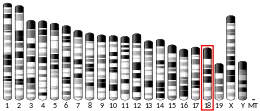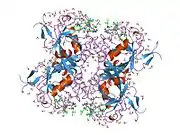| PPIC | |||||||||||||||||||||||||||||||||||||||||||||||||||
|---|---|---|---|---|---|---|---|---|---|---|---|---|---|---|---|---|---|---|---|---|---|---|---|---|---|---|---|---|---|---|---|---|---|---|---|---|---|---|---|---|---|---|---|---|---|---|---|---|---|---|---|
 | |||||||||||||||||||||||||||||||||||||||||||||||||||
| |||||||||||||||||||||||||||||||||||||||||||||||||||
| Identifiers | |||||||||||||||||||||||||||||||||||||||||||||||||||
| Aliases | PPIC, CYPC, peptidylprolyl isomerase C | ||||||||||||||||||||||||||||||||||||||||||||||||||
| External IDs | OMIM: 123842 MGI: 97751 HomoloGene: 727 GeneCards: PPIC | ||||||||||||||||||||||||||||||||||||||||||||||||||
| |||||||||||||||||||||||||||||||||||||||||||||||||||
| |||||||||||||||||||||||||||||||||||||||||||||||||||
| |||||||||||||||||||||||||||||||||||||||||||||||||||
| |||||||||||||||||||||||||||||||||||||||||||||||||||
| |||||||||||||||||||||||||||||||||||||||||||||||||||
| Wikidata | |||||||||||||||||||||||||||||||||||||||||||||||||||
| |||||||||||||||||||||||||||||||||||||||||||||||||||
Peptidyl-prolyl cis-trans isomerase C (PPIC) is an enzyme that in humans is encoded by the PPIC gene on chromosome 5. As a member of the peptidyl-prolyl cis-trans isomerase (PPIase) family, this protein catalyzes the cis-trans isomerization of proline imidic peptide bonds, which allows it to facilitate folding or repair of proteins.[5][6][7] In addition, PPIC participates in many biological processes, including mitochondrial metabolism, apoptosis, redox, and inflammation, as well as in related diseases and conditions, such as ischemic reperfusion injury, AIDS, and cancer.[8][9][10][11]
Structure
Like other cyclophilins, PPIC forms a β-barrel structure with a hydrophobic core. This β-barrel is composed of eight anti-parallel β-strands and capped by two α-helices at the top and bottom. In addition, the β-turns and loops in the strands contribute to the flexibility of the barrel.[10] PPIC in particular is composed of 212 residues and contains a hydrophobic, ER-targeting sequence at the N-terminal. The PPIase domain is homologous to PPIA and can be bound and inhibited by CsA.[6]
Function
The protein encoded by this gene is a member of the peptidyl-prolyl cis-trans isomerase (PPIase) family. PPIases catalyze the cis-trans isomerization of proline imidic peptide bonds in oligopeptides and accelerate the folding of proteins.[7] Generally, PPIases are found in all eubacteria and eukaryotes, as well as in a few archaebacteria, and thus are highly conserved.[8][12] The PPIase family is further divided into three structurally distinct subfamilies: cyclophilin (CyP), FK506-binding protein (FKBP), and parvulin (Pvn).[8][10] As a cyclophilin, PPI binds cyclosporin A (CsA) and can be found within the cell or secreted by the cell.[9] In eukaryotes, cyclophilins localize ubiquitously to many cell and tissue types, though PPIC especially is highly expressed in kidney.[9][10][13] In addition to PPIase and protein chaperone activities, cyclophilins function in mitochondrial metabolism, apoptosis, immunological response, inflammation, and cell growth and proliferation.[8][9][10] Along with PPIB, PPIC localizes to the endoplasmic reticulum (ER), where it maintains redox homeostasis. Depletion of these two cyclophilins lead to hyperoxidation of the ER.[11] In the brain, PPIC complexes with cyclophilin C-associated protein (CyCAP) to activate microglia and macrophage function via the calcineurin/NFAT pathway.[13]
Clinical Significance
As a cyclophilin, PPIC binds the immunosuppressive drug CsA to form a CsA-cyclophilin complex, which then targets calcineurin to inhibit the signaling pathway for T-cell activation.[9]
In cardiac myogenic cells, cyclophilins have been observed to be activated by heat shock and hypoxia-reoxygenation as well as complex with heat shock proteins. Thus, cyclophilins may function in cardioprotection during ischemia-reperfusion injury.[9] Similarly, PPIC may confer neuroprotection by forming a complex with CyCAP to activate survival mechanisms and mitigate ischemic damage in the brain.[13]
Currently, cyclophilin expression is highly correlated with cancer pathogenesis, but the specific mechanisms remain to be elucidated.[9] For instance, studies identify PPIC as a reliable indicator of circulating tumor cells in epithelial ovarian cancer (EOC) and, thus, may serve as a biomarker for detection and treatment of the cancer.[14]
Interactions
PPIC has been shown to interact with:
References
- 1 2 3 GRCh38: Ensembl release 89: ENSG00000168938 - Ensembl, May 2017
- 1 2 3 GRCm38: Ensembl release 89: ENSMUSG00000024538 - Ensembl, May 2017
- ↑ "Human PubMed Reference:". National Center for Biotechnology Information, U.S. National Library of Medicine.
- ↑ "Mouse PubMed Reference:". National Center for Biotechnology Information, U.S. National Library of Medicine.
- ↑ Sugano S, Kim DW, Yu YS, Mizushima-Sugano J, Yoshitomo K, Watanabe S, Suzuki F, Yamaguchi N (Oct 1992). "Use of an epitope-tagged cDNA library to isolate cDNAs encoding proteins with nuclear localization potential". Gene. 120 (2): 227–33. doi:10.1016/0378-1119(92)90097-9. PMID 1383094.
- 1 2 Schneider H, Charara N, Schmitz R, Wehrli S, Mikol V, Zurini MG, Quesniaux VF, Movva NR (Jul 1994). "Human cyclophilin C: primary structure, tissue distribution, and determination of binding specificity for cyclosporins". Biochemistry. 33 (27): 8218–24. doi:10.1021/bi00193a007. PMID 8031755.
- 1 2 "Entrez Gene: PPIC peptidylprolyl isomerase C (cyclophilin C)".
- 1 2 3 4 Kazui T, Inoue N, Yamada O, Komatsu S (Jan 1992). "Selective cerebral perfusion during operation for aneurysms of the aortic arch: a reassessment". The Annals of Thoracic Surgery. 53 (1): 109–14. doi:10.1016/0003-4975(92)90767-x. PMID 1530810.
- 1 2 3 4 5 6 7 Yao Q, Li M, Yang H, Chai H, Fisher W, Chen C (Mar 2005). "Roles of cyclophilins in cancers and other organ systems". World Journal of Surgery. 29 (3): 276–80. doi:10.1007/s00268-004-7812-7. PMID 15706440. S2CID 11678319.
- 1 2 3 4 5 Wang T, Yun CH, Gu SY, Chang WR, Liang DC (Aug 2005). "1.88 A crystal structure of the C domain of hCyP33: a novel domain of peptidyl-prolyl cis-trans isomerase". Biochemical and Biophysical Research Communications. 333 (3): 845–9. doi:10.1016/j.bbrc.2005.06.006. PMID 15963461.
- 1 2 Stocki P, Chapman DC, Beach LA, Williams DB (Aug 2014). "Depletion of cyclophilins B and C leads to dysregulation of endoplasmic reticulum redox homeostasis". The Journal of Biological Chemistry. 289 (33): 23086–96. doi:10.1074/jbc.M114.570911. PMC 4132807. PMID 24990953.
- ↑ Hoffmann H, Schiene-Fischer C (Jul 2014). "Functional aspects of extracellular cyclophilins". Biological Chemistry. 395 (7–8): 721–35. doi:10.1515/hsz-2014-0125. PMID 24713575. S2CID 32395688.
- 1 2 3 4 5 6 7 Yamaguchi R, Hosaka M, Torii S, Hou N, Saito N, Yoshimoto Y, Imai H, Takeuchi T (Jun 2011). "Cyclophilin C-associated protein regulation of phagocytic functions via NFAT activation in macrophages". Brain Research. 1397: 55–65. doi:10.1016/j.brainres.2011.03.036. PMID 21435337. S2CID 28737748.
- ↑ Obermayr E, Castillo-Tong DC, Pils D, Speiser P, Braicu I, Van Gorp T, Mahner S, Sehouli J, Vergote I, Zeillinger R (Jan 2013). "Molecular characterization of circulating tumor cells in patients with ovarian cancer improves their prognostic significance -- a study of the OVCAD consortium". Gynecologic Oncology. 128 (1): 15–21. doi:10.1016/j.ygyno.2012.09.021. PMID 23017820.
- 1 2 Trahey M, Weissman IL (Mar 1999). "Cyclophilin C-associated protein: a normal secreted glycoprotein that down-modulates endotoxin and proinflammatory responses in vivo". Proceedings of the National Academy of Sciences of the United States of America. 96 (6): 3006–11. Bibcode:1999PNAS...96.3006T. doi:10.1073/pnas.96.6.3006. PMC 15885. PMID 10077627.
Further reading
- Friedman J, Weissman I (Aug 1991). "Two cytoplasmic candidates for immunophilin action are revealed by affinity for a new cyclophilin: one in the presence and one in the absence of CsA". Cell. 66 (4): 799–806. doi:10.1016/0092-8674(91)90123-G. PMID 1652374. S2CID 205020327.
- Price ER, Jin M, Lim D, Pati S, Walsh CT, McKeon FD (Apr 1994). "Cyclophilin B trafficking through the secretory pathway is altered by binding of cyclosporin A". Proceedings of the National Academy of Sciences of the United States of America. 91 (9): 3931–5. Bibcode:1994PNAS...91.3931P. doi:10.1073/pnas.91.9.3931. PMC 43696. PMID 7909608.
- Friedman J, Trahey M, Weissman I (Jul 1993). "Cloning and characterization of cyclophilin C-associated protein: a candidate natural cellular ligand for cyclophilin C". Proceedings of the National Academy of Sciences of the United States of America. 90 (14): 6815–9. Bibcode:1993PNAS...90.6815F. doi:10.1073/pnas.90.14.6815. PMC 47023. PMID 8341703.
- Montague JW, Hughes FM, Cidlowski JA (Mar 1997). "Native recombinant cyclophilins A, B, and C degrade DNA independently of peptidylprolyl cis-trans-isomerase activity. Potential roles of cyclophilins in apoptosis". The Journal of Biological Chemistry. 272 (10): 6677–84. doi:10.1074/jbc.272.10.6677. PMID 9045699.
- Trahey M, Weissman IL (Mar 1999). "Cyclophilin C-associated protein: a normal secreted glycoprotein that down-modulates endotoxin and proinflammatory responses in vivo". Proceedings of the National Academy of Sciences of the United States of America. 96 (6): 3006–11. Bibcode:1999PNAS...96.3006T. doi:10.1073/pnas.96.6.3006. PMC 15885. PMID 10077627.
- Lim J, Hao T, Shaw C, Patel AJ, Szabó G, Rual JF, Fisk CJ, Li N, Smolyar A, Hill DE, Barabási AL, Vidal M, Zoghbi HY (May 2006). "A protein-protein interaction network for human inherited ataxias and disorders of Purkinje cell degeneration". Cell. 125 (4): 801–14. doi:10.1016/j.cell.2006.03.032. PMID 16713569. S2CID 13709685.
- Davis TL, Walker JR, Campagna-Slater V, et al. (2010). "Structural and biochemical characterization of the human cyclophilin family of peptidyl-prolyl isomerases". PLOS Biol. 8 (7): e1000439. doi:10.1371/journal.pbio.1000439. PMC 2911226. PMID 20676357.







